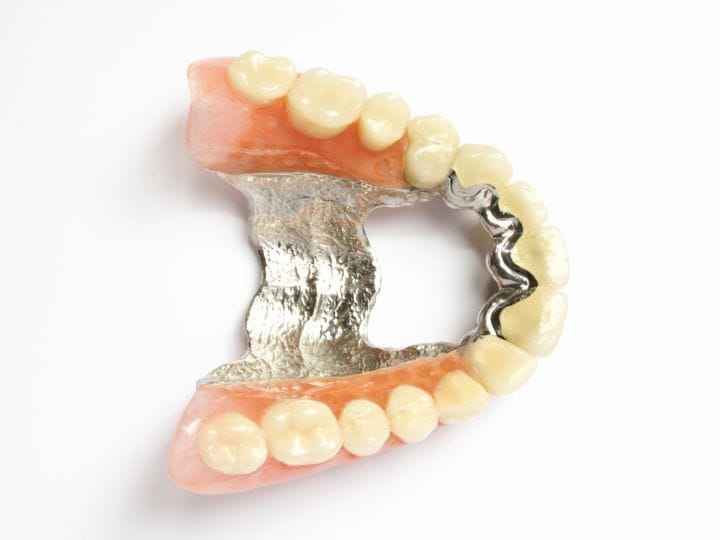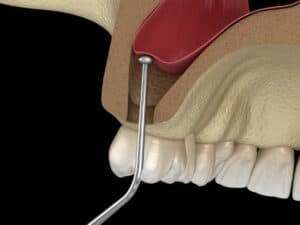Choosing how to replace your missing teeth can be daunting given the plethora of options available. There are various types of dentures, partial dentures, immediate dentures, and implant-supported dentures.

This comprehensive guide will help you understand the differences, benefits, and considerations of each option, allowing you the privilege to make an informed decision.
Whether you’re seeking a full set of dentures or partials to replace missing teeth, this article will provide valuable insights to guide you toward the most suitable dental solution for your unique needs.
Understanding Dentures and Partials
What are dentures?
Dentures are removable or fixed dental prosthetic devices that are designed to replace your missing natural teeth.
Typically they are made from acrylic resin and are often fabricated in combination with various metals.
Dentures are made on a metal framework that holds acrylic (a pink or gum-colored plastic material) and artificial teeth are fixed onto the acrylic base.
Dentures are custom-fitted for each patient. Dentures can be complete or partial. Conventional dentures replace all teeth in either the upper or lower jaw or sometimes both.
Whereas partial dentures may only replace one or more teeth in your mouth. Both might take support from dental implants for better stability.
What are partials?
Partials, partial dentures, or removable dentures, are also removable dental prosthetic devices but are used only when some of your natural teeth remain and only some are lost.
Partial dentures are anchored to or take support from the existing adjacent teeth via metal clasps or precision attachments. Partial dentures are made of acrylic resin material while the clasps and precision attachments are made of metal.

These too have to be custom-made for each patient. Partial dentures include cast-metal removable partial dentures, acrylic partial dentures, and flexible partial dentures.
Differences Between Dentures and Partials
Coverage and Replacement
The fundamental difference between full and partial dentures lies in the extent of tooth replacement.
Dentures or complete dentures are usually designed for those who have lost all of their teeth in the jaw thus providing full mouth coverage.
Partial dentures are used to replace one or several missing teeth and fill in the gaps while preserving the remaining healthy teeth of the individual.
Stability and Functionality
Dentures require a certain period of adjustment since they only take support from the jawbone and are not fixed to the jawbone. They might need denture adhesives or denture sealants to stay in place.
Complete dentures can take some time to get used to, especially when eating and speaking since they are less stable. Partials, however, being anchored to or supported by the existing teeth, often offer greater stability and a more natural feel during daily activities.
Cost and Maintenance
Generally, dentures are more expensive than partials due to the extensive work involved in their creation and the number of replacement teeth attached.
However, the cost of dentures can vary widely based on materials and complexity.
Maintenance for both options involves regular cleaning, removal at night, and periodic adjustments by a dental professional.
Benefits of Dentures
Full mouth coverage
For those missing all their teeth, complete dentures offer a complete solution, restoring the full functionality of the mouth.

They enable the denture wearers to eat a wider variety of foods and speak more clearly than they could without teeth.
Restored facial structure
Complete dentures can help maintain the facial structure by providing ample support to the cheeks and lips, which can sag and appear sunken in the absence of teeth thereby making you appear older. most importantly, they help restore your smile.
Improved chewing and speaking abilities
Even though there is an adjustment period, modern complete dentures are designed to improve chewing efficacy and clarity of speech, thereby, significantly enhancing the quality of life.
Benefits from Partial Dentures
Preserving the natural teeth

The primary advantage of a partial denture is that it is designed to work in harmony with the existing teeth. This helps preserve the health and structure of the remaining natural teeth by preventing them from shifting.
More affordable option
Partial dentures are typically less expensive than full dentures, making them a more accessible option for those looking to replace fewer teeth.
Easy to adjust and maintain
Partials can be easily adjusted to accommodate changes in the mouth, such as the shifting of teeth or changes in gum tissue, and are relatively easy to maintain.
Considerations When Choosing Between Dentures and Partials
Number of missing teeth
The choice between dentures and partials largely depends on the replacement for missing teeth.
Partials can replace one or more missing teeth, whereas a full set of dentures is more suitable for those who have lost most or all of their teeth.
Overall oral health
Your overall oral health, including the health of your remaining teeth and gums, will influence the decision. Conditions like gum disease might affect the suitability of partials.
Budget and insurance coverage
Cost is a significant consideration. It’s essential to review your budget and insurance coverage to understand what is financially feasible.
Making an Informed Decision
Consulting with a dentist
A thorough consultation with a dentist is crucial. They can assess your oral health, discuss your options, and recommend the best solution based on your specific needs.
Weighing the pros and cons
Carefully consider the advantages and disadvantages of each option. While dentures offer a comprehensive solution for those without teeth, partials are less invasive and help preserve existing natural teeth.
Considering long-term impact
Consider the long-term implications, including maintenance, comfort, and how they might affect your lifestyle. Both options require ongoing care and periodic replacements.








